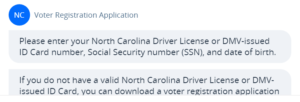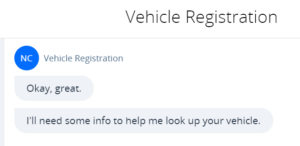With the use of conversational chatbots, state and local agencies can improve government to citizen communication and accelerate service delivery.
Key takeaways from this article include:
- Chatbots in government enable citizens to quickly find the information they need and take care of tasks such as bill payments and license renewals faster, whenever it’s convenient for them.
- Self-service with helpful bots also reduces the time agency employees spend answering basic questions and handling tasks like taking bill payments by phone.
- By making interactions easier and more convenient—and by making employees more available to handle complex issues—government chatbots can improve constituents’ opinion of the public sector.
What are chatbots and what’s their role in local government?
One of the clearest, simplest chatbot definitions comes from Chatbots Magazine: “a service, powered by rules and sometimes artificial intelligence, that you interact with via a chat interface.”
With artificial intelligence (AI), smart chatbots can use natural language processing (NLP) to have productive freeform conversations with users. Even without AI, well-designed rules-based workflow automation can help users select options from a menu to find answers to questions, access government services and make payments.
Chatbots’ ability to help people with routine tasks makes them a natural fit for budget-conscious organizations, including local governments, that want to reduce the amount of time their employees spend on basic, repetitive work.
The adoption of conversational chatbots has accelerated with the COVID-19 pandemic. When NASCIO’s 2021 State CIO Survey asked states’ chief information officers which emerging technologies and automation solutions were adopted in response to the pandemic, chatbots were the top answer. In addition to delivering services without employee engagement, government chatbots can create a better citizen experience for your residents and are a simple way to jump-start your government digital transformation.
Government chatbots can improve public-sector service delivery
The range of potential chatbot applications is as vast as the types of services that government agencies provide to enhance civic engagement. Most local governments roll out their chatbot program with one service, such as property tax payments or vital records lookup, and then expand support to other digital services and online payments to increase their operational efficiency.
The chatbot value proposition: Increase civic engagement and improve operational efficiency
Here are four specific benefits of chatbots in government:
- Chatbots can help prioritize public health service delivery. An example is the use of bots to help citizens assess COVID-19 symptoms. This allows public health nurses to reduce the time they spend with asymptomatic callers, so they can help more people experiencing coronavirus symptoms.
- Chatbots can provide internal support for government employees. For example, a chatbot can guide workers through processes such as password changes, freeing up support desk time. IT technicians can then focus on more urgent issues enabling better service delivery in the public sector.
- The use of government chat apps can help residents securely pay their property taxes. Powered by PayIt’s technology, Beaufort County, South Carolina’s tax chatbot, TaxBot, walks property owners through the tax payment process. TaxBot also provides users with a digital receipt and can send reminders when their next bill is due.

- Chatbots can help residents with more than one service. In North Carolina, residents can register new vehicles, renew registrations and driver’s licenses, order license plates, register to vote and update their address in one citizen self-service portal with help from a versatile chatbot. So far, the conversational workflow built into the myNCDMV chatbot and portal has generated a 25% increase in online revenue collection and a 40% reduction in DMV office wait times.
Conversational chatbots improve the citizen self-service portal experience
The federal USAGov website ran a self-service chatbot pilot program to answer citizen questions about scams. As part of the test program, the USAGov team asked for feedback from chatbot users. Among their findings:
- Many citizens said they’d rather chat than call a helpline, especially if the phone call leads to an interactive voice response (IVR) system with a long introductory menu, or if they have to spend a long time on hold.
- Users were most satisfied with the chatbot’s ability to answer simple, straightforward questions—the kind that a rules-based chatbot is specifically designed to handle.
- Users also expected to have a way to talk with a real person if the chatbot couldn’t resolve their issue.
Chatbot users with other government agencies have also shared positive feedback about how quickly they were able to take care of tasks such as driver’s license renewals and property tax payments, without having to wait in long lines.
“Honestly, I like the ‘tax bot’ better than most of the people I have to text with!”
— myBeaufortCounty user
This kind of positive, easy self-service experience can improve public opinion about—and support for—government agencies that provide conversational AI or rules-based chatbots.
Chatbots can help drive digital transformation in local government
As government services chatbots become more common, agencies will almost certainly find more applications for them. For example, North Carolina’s DMV added voter registration to its chatbot capabilities after establishing driver’s license and vehicle registration. That provides a model for local governments that start with a chatbot for one service, such as utility bill payments, and then scale up to add other services like vital records requests and property tax payments.
As a government organization adds more chatbot functions, it frees more resources to invest in other technological upgrades that can improve government to citizen communication, operational efficiency, data security and employee experience.
Will chatbots in local government replace call centers entirely? That’s debatable. For now, there are limits to the complexity that even a powerful AI-driven chatbot can handle, so there’s a need for experienced employees to handle those cases. What chatbots can do is enable government call centers to focus on complex cases, so that citizens can get the help they need faster.
See how conversational workflow automation improves citizen engagement
PayIt builds intuitive and engaging workflows for all kinds of city, county and state services as part of an award-winning digital government platform, and we’d love to show you what we can do for you. Request your customized PayIt demo today.


